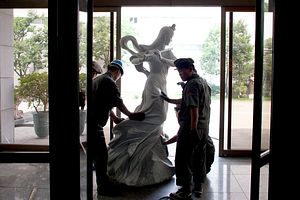It was an art piece that broke the ice before the inter-Korean summit in April between North Korean leader Kim Jong Un and South Korean President Moon Jae-in. After seeing a painting in the lobby of the Inter-Korean Peace House, Kim reportedly expressed his interest by saying, “What technique was used to draw this?” Moon replied, and their conversation was continued.
The two Koreas are gearing up to increase inter-Korean cooperation and exchanges, and the field of art is no exception. South Korea’s Ministry of Culture, Sports, and Tourism, for instance, is preparing for various cultural and artistic exchanges with the North, including academic comparative research, seminars, and exhibitions.
Art has been one of the few areas of exchange between the two Koreas. If North Korean artworks are to be brought into South Korea, they must be checked and registered with government organizations such as the Ministry of Unification and the Ministry of Foreign Affairs. There is also a very low level of understanding and interest in North Korean art among ordinary people in South Korea.
Outside South Korea, there is greater interest in North Korean artworks. Although there is no open channel to trade North Korean art pieces, they are highly sought after by many collectors. The closed nature of North Korea’s isolationist society means art from the country serves as a curiosity, Korea Culture & Tourism Institute researcher Park Young-jeoung notes.
North Korea seems to fully understand this situation and knows how to take advantage of it.
Take a look at the “Korea Traditional art center” as an example. North Korea operates the center in Beijing’s 798 Art Zone, which is famous among artists, collectors, and tourists.
Its original purpose is to promote North Korean culture and cultural exchanges with foreign countries, and the center was founded around two years ago. But it has already become a must-visit place for collectors who hope to buy art pieces from North Korea. The art center sells different types of artworks, including paintings; it also offers a service to draw portraits of customers by North Korean artists.
Paintings usually cost about $500, but those drawn by famous painters can sell for up to $1,600.
The center even operates a website and provides a customer center until 9 p.m. every day, hinting that it is actively seeking buyers across the world.
Apart from official channels like the cultural center, North Korea is also eager to seek buyers with stronger purchasing power more privately.
Merchants and traders dispatched from Pyongyang are responsible for such a task. They bring high-end artworks from the North and present them at exclusive art exhibitions. Some artworks at these exhibitions are traded at over $150,000.
Many believe this is a part of the North Korean government’s effort to secure foreign money to overcome difficulties amid international sanctions.
For a long time, art pieces have been on the sanctions list from the United Nations or any other individual country. But the situation changed a bit in August last year, when the UN Security Council introduced a resolution to include North Korea’s Mansudae Art Studio in its sanction lists.
The Mansudae Art Studio, which was founded in 1959, is an art studio in the North Korean capital of Pyongyang. The studio employs around 4,000 people, 1,000 of whom are artists picked from the best academies across North Korea.
The studio consists of 13 groups, including those for woodcuts, charcoal drawings, ceramics, embroidery, and jewel paintings. Artists do not receive the profits from their works, as all proceeds go to the government. The largest profits, of course, come from selling art pieces to overseas buyers.
The UN sanctions on the studio triggered an investigation in April into North Korea’s art gallery in Abu Dhabi, which presents and sells art pieces from Mansudae Art Studio. The works range from small postcards to large-sized paintings.
However, some are still skeptical of how effective the new sanctions on art sales can be. According to a report by Korea Trade-Investment Promotion Agency or Kotra, the new resolution has had little impact on North Korea’s artwork sales in China due to lax monitoring. North Korea is actively promoting its artworks through exhibitions and sales activities to attract foreign buyers in major cities like Beijing and Shanghai and large provinces such as Guangdong and Shandong, the agency notes.
The result is that North Korea has been able to make more than $160 million by selling art over the past 10 years. That’s a lot, given the tight sanctions that Pyongyang has been under.

































